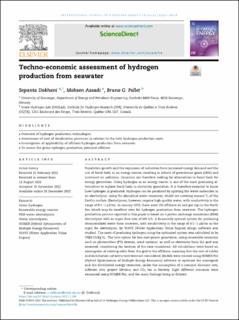| dc.identifier.citation | Dokhani, S., Assadi, M., & Pollet, B. G. (2023). Techno-economic assessment of hydrogen production from seawater. International Journal of Hydrogen Energy, 48(26), 9592-9608. | en_US |
| dc.description.abstract | Population growth and the expansion of industries have increased energy demand and the use of fossil fuels as an energy source, resulting in release of greenhouse gases (GHG) and increased air pollution. Countries are therefore looking for alternatives to fossil fuels for energy generation. Using hydrogen as an energy carrier is one of the most promising alternatives to replace fossil fuels in electricity generation. It is therefore essential to know how hydrogen is produced. Hydrogen can be produced by splitting the water molecules in an electrolyser, using the abondand water resources, which are covering around ⅔ of the Earth's surface. Electrolysers, however, require high-quality water, with conductivity in the range of 0.1–1 μS/cm. In January 2018, there were 184 offshore oil and gas rigs in the North Sea which may be excellent sites for hydrogen production from seawater. The hydrogen production process reported in this paper is based on a proton exchange membrane (PEM) electrolyser with an input flow rate of 300 L/h. A financially optimal system for producing demineralized water from seawater, with conductivity in the range of 0.1–1 μS/cm as the input for electrolyser, by WAVE (Water Application Value Engine) design software was studied. The costs of producing hydrogen using the optimised system was calculated to be US dollars 3.51/kg H2. The best option for low-cost power generation, using renewable resources such as photovoltaic (PV) devices, wind turbines, as well as electricity from the grid was assessed, considering the location of the case considered. All calculations were based on assumption of existing cable from the grid to the offshore, meaning that the cost of cables and distribution infrastructure were not considered. Models were created using HOMER Pro (Hybrid Optimisation of Multiple Energy Resources) software to optimise the microgrids and the distributed energy resources, under the assumption of a nominal discount rate, inflation rate, project lifetime, and CO2 tax in Norway. Eight different scenarios were examined using HOMER Pro, and the main findings being as follows:
The cost of producing water with quality required by the electrolyser is low, compared with the cost of electricity for operation of the electrolyser, and therefore has little effect on the total cost of hydrogen production (less than 1%).
The optimal solution was shown to be electricity from the grid, which has the lowest levelised cost of energy (LCOE) of the options considered. The hydrogen production cost using electricity from the grid was about US dollars 5/kg H2.
Grid based electricity resulted in the lowest hydrogen production cost, even when costs for CO2 emissions in Norway, that will start to apply in 2025 was considered, being approximately US dollars 7.7/kg H2.
From economical point of view, wind energy was found to be a more economical than solar. | en_US |

